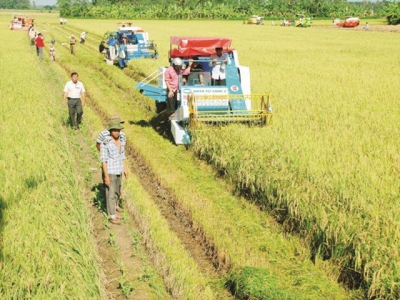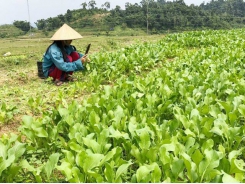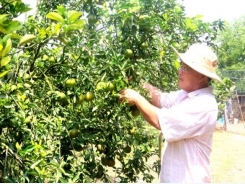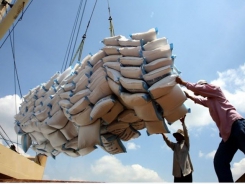Rice export grows steadily

Contrary to the chorus of "increasing volume, reducing price" as many years ago, in recent years, especially from 2017 to now, rice exports have continuously noted the "change vigorously" when increasing both in terms of quantity and value, increasingly conquering difficult markets.
Recently, export rice has achieved quite positive results in terms of quantity, price as well as structure and type of export. Source: Internet.
Export prices continue to rise
According to the report of the Ministry of Industry and Trade, rice export has achieved positive results in terms of quantity and price, as well as structure and type of export. Specifically, rice exports in 2017 reached 5.82 million tons, up 21% from 2016, worth about $ 2.63 billion USD, up 22%. The average FOB price was 452.6 USD per ton, an increase of 0.8 per cent compared to the export price in 2016. Growth continued to be maintained in 2018. By the end of 15th September, rice export reached 73 million tons, up 9.3% over the same period in 2017, worth $ 2.38 billion USD, up 24.8%. Average FOB export price reached 503.3 USD per ton, up 62.4 USD per ton over the same period last year. Notably, the structure and type of export rice has shifted positively, gradually increasing to white rice of medium and high quality, aromatic rice, gradually reducing white low quality rice. In the first eight months of this year, low quality white rice accounted for only 2.07% of total export rice. Meanwhile, high quality white rice and average rice accounted for 42.46% and aromatic rice accounted for 33.24% of the total export rice of Vietnam.
Regarding this issue, Deputy Minister of Industry and Trade Do Thang Hai said that Vietnam exports about 15% of the total world rice export volume annually. Vietnam rice is exported to nearly 150 countries and territories with a variety of products such as: Long grain rice, short grain rice, aromatic rice, rice, organic rice... Notably, Vietnamese rice has initially penetrated into high demand markets such as Korea, Japan, USA, EU...
Around the rice sector story, Deputy Minister of Agriculture and Rural Development Tran Thanh Nam added: From the end of 2017 to now, Vietnam's rice export price continued to increase. In addition to the world's demand for rice, there is another important reason: the restructuring of rice production and rice export towards lower and middle grades of rice, high quality rice, and aromatic rice specialties in the past years. In addition, mentioning rice production, Deputy Minister Tran Thanh Nam pointed out that, "The rate of mechanization in rice production is high, especially in the Mekong Delta harvested by combined harvesters increased from 50% (in 2010), and so far has reached 100% of the area of cultivated rice; The drying rate increased from 40% in 2010 to 90% today. The processing plants have been developed and have the capacity to meet the export target, satisfying high demanding markets in terms of the EU, US and Japan."
Still many challenges
Although there are positive changes, but Deputy Minister Tran Thanh Nam, said for production, Vietnam rice export has been facing many challenges. Vietnam is one of the five countries most affected by climate change. Floods, droughts and saline intrusion often occur with increased frequency and intensity, which has a great impact on agricultural production in general and rice production in particular. In addition, global competition in rice production and trading is increasing, especially in terms of quality and value; Infrastructure in rice production is limited, especially the logistic issues... are also the factors that prevent the export of rice.
Deputy Minister Do Thang Hai assessed: Accessibility, market entry, marketing, contract negotiation, international trade dispute settlement, global value chain participation of traders export and rice export is limited. In addition, Vietnam’s brand name product is the least known by the majority of consumer countries. End consumers mostly know free rice through another brand name or as just processed rice. These are some points in the rice industry in Vietnam that need to continue to overcome and improve in the coming time.
In fact, in addition to the above issues, recently, a number of barriers, most non-tariff barriers have appeared; impacting not less on Vietnam’s rice exports. Typically, the story of Vietnam's top rice export market is that China maintains a strict import regime through quotas, strict food safety checks. Not only China, this trend is also applied by other countries, forcing rice exporters to face more intense competition. However, according to Mr. Tran Thanh Hai, deputy head of the Import-Export Department (Ministry of Industry and Trade), "From another perspective, this fact also motivates Vietnamese enterprises to compete and raise their competitiveness. As compared to competitors in countries such as Thailand, India, Bangladesh, Myanmar... Thus, new businesses have export activities internationally, not only based on quantity or low grade rice but compete with quality, professionalism."
Focus on production chain
Around the story of rice production, the Import-Export Department (Ministry of Industry and Trade) clearly stated: Orientation for development, production and export of rice in the coming time is to concentrate on production processes, clean organic rice, and diversify products processed from rice; Organizing production according to standard procedures, synchronous from breeding, cultivation, harvesting, processing and packaging; To build specialized areas for production of quality rice; Building reputation, brand name rice of Vietnam in the world market.
Regarding this issue, Deputy Minister Tran Thanh Nam emphasized that MARD will focus on investing in research and development of high quality rice varieties to meet domestic and export demands; To build the key rice-producing regions in order to ensure food security and export, to concentrate resources on investment in synchronous infrastructure in the production areas. Specifically, in the Mekong Delta it will develop waterways and road systems, increasing the connection from the specialized farms to Can Tho port to be able to export rice to the West ...; At the same time, the Ministry of Agriculture and Rural Development will promote the processing, preservation and processing as well as the application of modern technology and management techniques to reduce the time for ships at ports, reduce costs of loading and unloading... “In addition, MARD will also promote rice processing, preservation, preliminary processing and intensive production; Raise the Vietnamese rice brand at the international level to increase the value of Vietnam rice," said Deputy Minister Tran Thanh Nam.
Some experts said that Vietnamese rice needs to be known by international consumers, first of all by building specialized areas for quality rice production. These regions are produced by synchronous processes. In particular, the construction of prestige with the brand name of Vietnam rice in the world market must be emphasized, to give greater importance.
From the perspective of exporters of rice, based on experience, Mr. Huynh Van Thon, Chairman of the Board of Directors of Loc Troi Group, said, "For Vietnamese rice to be branded and compete in the international market, it is important to apply the method of production in the sustainable value chain. At that time, businesses and people plan together, concentrate on raw materials, production by type in large fields. Through this association, the quality of rice will be tightly controlled, creating trust. In the coming time, businesses need more support from the government to cooperate closely with farmers as well as scientific researchers to create large production areas," he emphasized.
Có thể bạn quan tâm
Phần mềm

Phối trộn thức ăn chăn nuôi

Pha dung dịch thủy canh

Định mức cho tôm ăn

Phối trộn phân bón NPK

Xác định tỷ lệ tôm sống

Chuyển đổi đơn vị phân bón

Xác định công suất sục khí

Chuyển đổi đơn vị tôm

Tính diện tích nhà kính

Tính thể tích ao hồ



 Israel to introduce agro & water technologies and…
Israel to introduce agro & water technologies and…  Local firms win bid to supply rice for…
Local firms win bid to supply rice for…